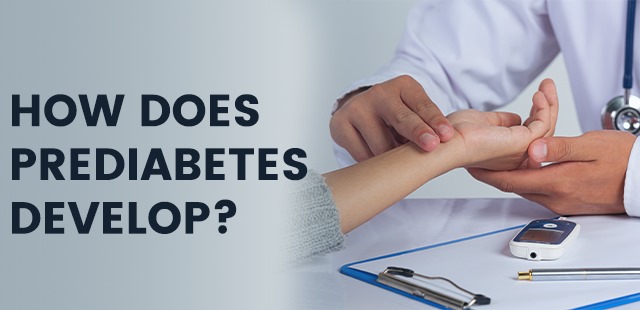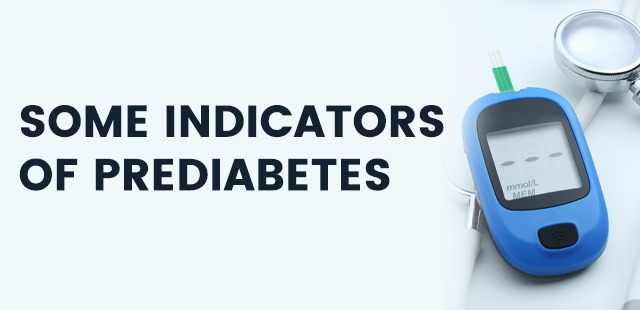Prediabetes – This is important

What is Pre-diabetes?
A non-diabetic person has the following blood glucose profile :
Fasting blood glucose less than 100 mg/dl HbA1c less than 5.7%
A person has diabetes if his blood glucose profile is : Fasting blood glucose more than 125 mg/dl HbA1c more than 6.5%
What about fasting blood glucose 100 – 125 mg/dl or HbA1c 5.7 – 6.5 %? This state is termed as Prediabetes.
Why is Prediabetes important?
Most estimates put the prevalence of prediabetes between 25 to 33% of the adult population in the developed world. In our country estimates vary between 10 to 20% of the adult population. We have to note that this is a very huge number and can be considered a modern epidemic considering its consequences on health.
This condition is mainly asymptomatic and can be found to continue even for decades before the onset of diabetes. It is also reversible to a greater extent and thus it may be more beneficial to address it. Diabetes on the other hand is much more challenging to reverse. As diabetes develops there is progressive damage to many body tissues like the retina, kidneys, nerves, blood vessels etc. Progress to diabetes from a prediabetic state comes with a variety of health issues that vastly reduce the quality of life, greatly increase the cost of healthcare and despite the best efforts the outcomes are poor.

How does Prediabetes develop?
Prediabetes is a condition of poor glycemic (blood glucose levels) control. It is generally considered to result from the onset of insulin resistance. This happens when the body is exposed to high levels of insulin for prolonged periods and eventually, the tissues’ response to insulin is blunted. This results in higher than normal blood glucose levels. This mechanism gives way eventually as diabetes develops.
Various causes are implicated for Prediabetes. Most of them are lifestyle and diet-related.
Being overweight, frequent eating, imbalanced diet, stress, inactive lifestyle, substance addictions and poor sleep have all been implicated. In addition, a family history of diabetes is also contributory. Increasing stress in adults with an already sedentary lifestyle and faulty habits has been implicated as the reason for the reduction in the age of prediabetes.

Some indicators of Prediabetes
Prediabetes increases with age. Especially after the age of 40 years. Although it’s of note that this age has been coming down. Many individuals between 30 to 40 years old are being found to be prediabetic. Some indicators can be considered as weight, central body fat (belly, waist, chest, back), frequent hunger and eating, darkened armpits (acanthosis nigricans) and neck skin and skin tags. In females, polycystic ovary syndrome is a condition with close association with diabetes.
Association with metabolic syndrome
A condition characterised by abdominal fat, high blood pressure, increased triglyceride levels, low HDL levels and increased blood glucose is termed as metabolic syndrome.
It is frequently co-occurring with prediabetes. Such conditions are still reversible with changes in diet and lifestyle. Left unchecked, a progression to frank diabetes is imminent.
What has to be done?
If your blood tests or various other markers mentioned above indicate a prediabetic or metabolic syndrome state, then it should be taken as a call for changes in lifestyle.
A proactive approach to health must be taken. The importance of preventing the progress to diabetes needs to be highlighted.
Lifestyle modifications are the centre of addressing the problem. Frequent eating needs to be stopped at the earliest. Carbohydrate and sugar intake should be evaluated and reduced.
Healthy proteins and fats should be taken in the right amounts. Fibres need to be increased in the diet. Addictions need to be addressed. Smoking must be stopped and alcohol intake kept to a minimum. Exercise is a great tool to go along with the above steps with great health benefits.
An evaluation by a physician may be considered if multiple indicators are present. A detailed blood and hormonal workup may be undertaken by your physician.
A dietician consultation may also be required. If high blood pressure or other metabolic syndrome components are also present, an evaluation by the cardiologist may also be required. Stress management and sleep improvement are also critical.
Conclusion
Prediabetes is a reversible state of many future health issues. It requires a proactive approach from the individual. Do not hesitate to get an evaluation as early as possible. The right advice at the right time may be the enabler of a long and joyous life.